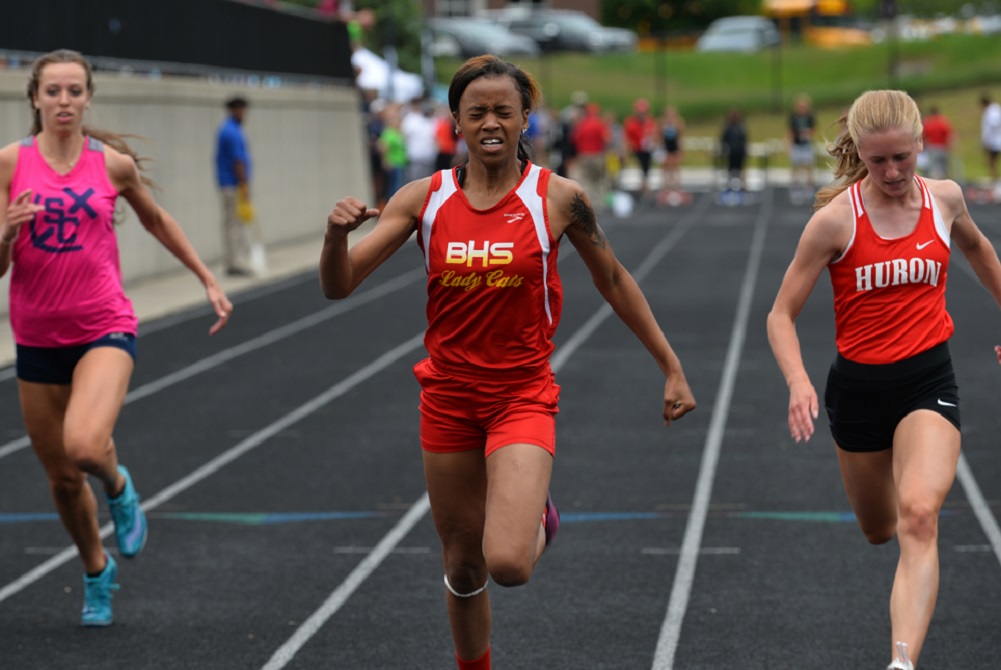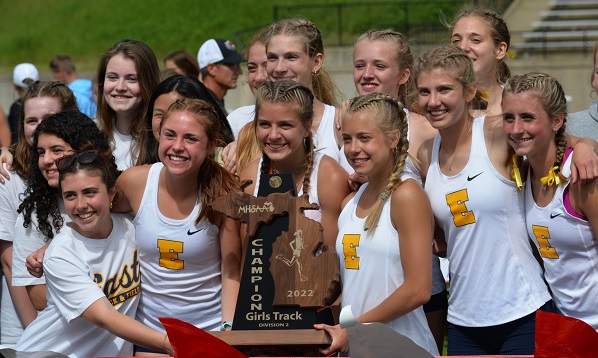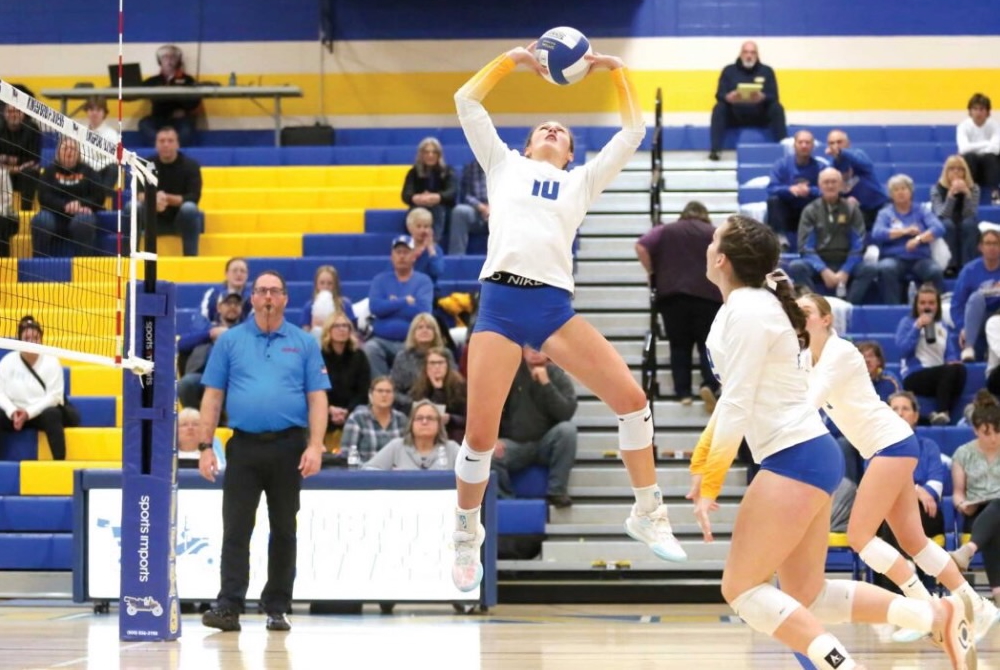
Madison Overcomes to Win Again, EGR Emerges to Add to Title Tradition
By
Steve Vedder
Special for MHSAA.com
June 4, 2022
ADA – After four years, Chaniya Madison knew she was out of tomorrows.
The Bridgeport sprinter accepted that the odds of capturing a rare third Lower Peninsula Division 2 Finals title in the 100-meter dash depended largely on health. And if that was the case, Madison admitted a mysterious knee that has baffled doctors for four years would have much to say about the final result.
There were dark times because of the injury when Madison thought about giving in to the pain, calling it a career and moving on to something else.
But after Saturday's Finals at Forest Hills Eastern, Madison is glad she didn't.
She won her third championship in the 100 with a time of 12.07. The title comes after winning the event in both her freshman and junior seasons and caps four seasons of ignoring knee pain that nearly ended her career several times. It took nearly four years for doctors to determine Madison suffered from fluid of the knee, first in her left and then in her right knee. Madison said doctors tried since her freshman year to diagnose the problem, which they guessed could have been anything from arthritis to a torn muscle.
Even after the knee was finally drained, Madison said she considered herself only 85-percent healthy.
"I lost my will to participate, my mental health and my will to stick to it," Madison said. "But I took a few days off and decided I didn't care how much pain there was. This is a big relief. After being so tired, I just wanted to cry. This is so emotional for me."
Madison also helped the Bridgeport 800 relay finish first (1:44.14).
While Madison headed the individual winners, East Grand Rapids captured the team title with 66 points to 37.6 for runner-up Grand Rapids Christian. Zeeland East was third with 29 points, Hudsonville Unity Christian fourth with 23.6 and Allendale and New Boston Huron tied for fifth with 21.
The team title was the 146th state championship for the East Grand Rapids athletic program, but first for the girls track & field team. That's a fact coach Mike Dykstra said he carefully passed along to his athletes this season.
 "Maybe it's a bit overwhelming," Dykstra said of joining the Pioneers' lengthy history of state championships. "We thought this was a chance to make history, and they bought into it. It was definitely a goal of ours. We have that as a goal at the start of every year. This was a pretty special year."
"Maybe it's a bit overwhelming," Dykstra said of joining the Pioneers' lengthy history of state championships. "We thought this was a chance to make history, and they bought into it. It was definitely a goal of ours. We have that as a goal at the start of every year. This was a pretty special year."
The Pioneers collected individual titles by Camryn Bodine in the 800 (2:12.46) and Drew Muller in the 1,600 (4:51.41) while also winning the 3,200 relay, which included Muller and Bodine (9:25.89).
Ludington senior RyAnn Rohrer had a big day winning the shot put (41-11) and discus (135-07). Like Madison, Rohrer had to overcome injury to win her titles. She suffered a leg injury after just two meets this spring and had to focus on getting healthy for the next two months. Rohrer not only had to overcome injury, she added the discus this season after a string of prior successes in the shot.
“I had to do a lot of work to improve, a lot of reps," said Rohrer, whose parents were both involved in throwing events in college. "I got very frustrated, so this is a relief. I knew I could do it, but sometimes it takes time and a mental ability. I had goals as a senior in the discus and I thought, ‘Why not take on a new challenge?’ I'm open to new things.”
Warren Regina junior Ella Jenkins won the 300 hurdles (44.99) and nearly won the 100 hurdles, finishing second (14.97) to Chelsea sophomore Leila Wells (14.96).
Jenkins was a Finals qualifier in the 100 hurdles a year ago and was seeded first in both events this season.
"I thought I had a shot," Jenkins said of winning the 100. "I always want to get out strong and finish with what I have left. I compete to win; I have a passion to win."
Grand Rapids Christian senior Madelyn Frens won the 3,200 (10:44.24). She said comparing Saturday's title with winning last fall's Division 2 cross country championship is not a stretch. Both, she said, involved mental strength. She also competed in the 1,600, where she was second, and the 3,200 relay, which finished runner-up to EGR.
"I like cross country because it's a little harder mentally, and it's longer," she said. "But this is more competitive, and it feels like there is more pressure with expectations. You have to push yourself mentally through both."
Elizabeth Anderson of New Boston Huron was a double winner in the 200 (25.07) and 400 (56.28).
Other champions included Linden in the 400 relay (49.41) and Dearborn Divine Child in the 1,600 relay (4:00.83).
In the field events, Natalie Christnagel of Grosse Ile won the high jump (5-4), Jordyn Wright of Tecumseh took the pole vault (12-0) and Lindsay Girard of Marine City took first in the long jump (17-7).
PHOTOS (Top) Bridgeport's Chaniya Madison, middle, crosses the finish line first in the 100 meters Saturday at Forest Hills Eastern. (Middle) East Grand Rapids celebrates its first girls track & field Finals championship. (Click for more from Dave McCauley/Run Michigan.)

Kingsford's Kreider Prepared for Next Level After Finishing Stellar Flivvers Career
By
John Vrancic
Special for MHSAA.com
June 19, 2025
KINGSFORD — After completing a successful high school volleyball career, Maddy Kreider is ready to take the next step.
 The Kingsford senior is taking her talents to Michigan Tech, where she’s expected to continue primarily as a setter.
The Kingsford senior is taking her talents to Michigan Tech, where she’s expected to continue primarily as a setter.
“That will be a big step for sure, but it’ll be exciting being with the girls,” she said. “The girls are taller in college. It will definitely be an adjustment, physically and mentally. We’ll be traveling longer distances, and it’ll be a matter of improving the mental part of my game.”
Kreider was selected the Upper Peninsula’s Defensive Player of the Year her final two seasons after the U.P. Sportswriters and Sportscasters Association began voting for all-U.P. volleyball.
“That’s quite an accomplishment,” she said. “It’s a real honor playing with girls I grew up with. We had a great season.”
The 5-foot-8 setter was a four-year starter and two-year team captain at Kingsford, leading the Flivvers to three Division 2 District titles and back-to-back undefeated Great Northern Conference championships. She twice was named GNC Player of the Year.
She was also selected all-state first team in the fall and all-state second team in 2023, and all-region throughout her prep career. Her serving percentage also topped .900 throughout her four seasons on varsity.
 Last fall, the Flivvers reached the Regional Semifinal at Manistique where they dropped a 3-2 decision to Kingsley.
Last fall, the Flivvers reached the Regional Semifinal at Manistique where they dropped a 3-2 decision to Kingsley.
“I thought we’d get through,” Kreider said. “We came out lights out in the first two sets, then it was close in the last three.”
Also among the team’s highlights this past fall was a victory at Calumet, approximately 2½ weeks after dropping a 3-1 decision to the Copper Kings on Kingsford’s home floor.
“We wanted to play them,” Kreider said. “They’re a great bunch of girls to play against. They’ve been the measuring stick up here for many years. Winning on their floor was super exciting. We knew we had to play well just to be competitive. That was a great confidence builder for our group. We were definitely on a high going into the District.”
The Flivvers opened their postseason with a 3-1 triumph over Houghton, then defeated Escanaba in straight sets in the District Final.
Kreider will join Calumet senior Maddie Torola at MTU this fall. Torola, who recorded a season-high 19 kills in the four-set victory at Kingsford, helped the Copper Kings finish 29-5 and reach the Division 3 Regional Final at Sault Ste. Marie where they dropped a 3-2 decision to Traverse City St. Francis.
“It was fun playing against her in high school,” Kreider said. “It will be even more fun playing as teammates. It’ll be exciting to be playing on the same team.”
Both will be playing under new head coach Cindy Pindral at Tech. Both of Kreider’s parents played for the Huskies, her mother (and Kingsford varsity coach) Jaclynn volleyball from 1998-2002 and her father Jason basketball from 1997-2000.
Maddy Kreider recently earned an additional honor when she was selected Female Athlete of the Year for Kingsford’s Class of 2025. She recently completed a solid track & field season for the Flivvers.
At the U.P. Division 1 Finals, Kreider placed fourth in the 100-meter dash (13.2) and anchored the Flivvers to a third-place finish in the 800 relay (1:51.57) and fourth in the 400 (53.03) on their home track.
Kreider was named one of 32 MHSAA/Farm Bureau Insurance Scholar-Athlete Award winners this winter and plans to study exercise science and kinesiology at MTU.
 John Vrancic has covered high school sports in the Upper Peninsula since joining the Escanaba Daily Press staff in 1985. He is known most prominently across the peninsula for his extensive coverage of cross country and track & field that frequently appears in newspapers from the Wisconsin border to Lake Huron. He received the James Trethewey Award for Distinguished Service in 2015 from the Upper Peninsula Sportswriters and Sportscasters Association.
John Vrancic has covered high school sports in the Upper Peninsula since joining the Escanaba Daily Press staff in 1985. He is known most prominently across the peninsula for his extensive coverage of cross country and track & field that frequently appears in newspapers from the Wisconsin border to Lake Huron. He received the James Trethewey Award for Distinguished Service in 2015 from the Upper Peninsula Sportswriters and Sportscasters Association.
PHOTOS (Top) Kingsford’s Maddy Kreider sets for her teammates during a match last season. (Middle) Kreider, right, takes a photo with Kingsford’s Male Athlete of the Year Gavin Grondin. (Photos provided by the Kingsford athletic department.)

